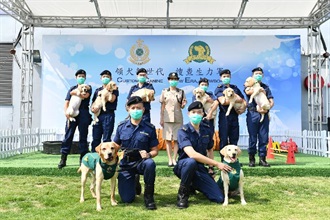Hong Kong Customs achieves tremendous breakthroughs in canine development (with photos)
3 Nov 2020
Hong Kong Customs has achieved tremendous breakthroughs in its canine profession this year. On top of upgrading the original Customs Detector Dog Division to become the Customs Canine Force (CCF), the first batch of six self-bred Labrador puppies were also born at the new breeding centre located at the Hong Kong-Zhuhai-Macao Bridge Control Point and officially opened in February this year. Co-operation with a local university took place as well in organising the first canine breeding training course for officers in a bid to enhance their professionalism in the area. The encouraging breakthroughs have brought about major elevation of the Customs canine team in both software and hardware development.
Following an organisational reshuffle in June this year, the original Customs Detector Dog Division has now been upgraded and renamed as the CCF with a manpower strength of more than 100 officers. Enhancements have been made in both the staffing and facility development, with the team's position strengthened as a result. In a bid to raise the department's enforcement capacity at boundary control points, the CCF is now striving to step up its strength in puppy raising and canine detection work with a dedicated focus on "Care", "Coach" and "Foster".
The birth of six self-bred Labrador puppies at the newly built breeding centre on July 25 this year was a particularly encouraging breakthrough in the department's history since detector dogs were introduced in 1975.
On the staff training front, Customs collaborated with the City University of Hong Kong this year to organise the first Canine Breeding Training Programme for the CCF officers. Courses of this type will be arranged in the future to raise continuously the officers' professionalism in canine breeding.
Noting that 2020 is a significant year for the Customs detector dog team, the Assistant Commissioner of Customs and Excise (Boundary and Ports), Ms Ida Ng, said today (November 3) that the various breakthroughs have reflected the new heights reached in the development of the department's canine team, adding that successful in-house breeding also ensures stable canine supply for the team's development.
The CCF will design the training programme for the self-bred puppies. They will start to perform sniffing duties when they reach a suitable age and pass the assessments required.
As a regional and international passenger and cargo hub, Hong Kong has an extremely heavy flow of people and goods. With different clearance modes in place for a growing number of control points, a long-term development strategy for the detector dog team needs to be exercised along the directions of diversification and professionalisation, so that the team's size and function will be able to meet the enforcement needs.
In terms of diversification, Ms Ng said that the CCF is committed to expanding its dogs' abilities to gun detection, on top of searching for three types of items at present: drugs, explosives and cash. The ability to intercept illegal arms and gun parts will help the department gear up for counter-terrorism work.
In a bid to speed up professionalisation to meet all types of operational challenges, preparations for accreditation for the Detector Dog Handling Training Programme under the Qualifications Framework of the Hong Kong Council for Accreditation of Academic and Vocational Qualifications are in full swing.
Looking ahead, the CCF will continue its development in three aspects, namely canine breeding, puppy nurturing and staff training, under the two said directions, so that detector dog management can become another branch of professionalism for the department.
Ends/Tuesday, November 3, 2020
Press Release
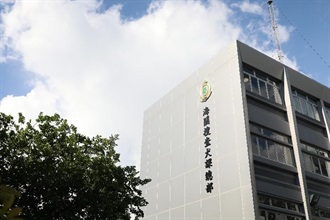
 Hong Kong Customs has achieved tremendous breakthroughs in its canine profession this year. Following an organisational reshuffle in June this year, the original Customs Detector Dog Division has now been upgraded and renamed as the Customs Canine Force.
Hong Kong Customs has achieved tremendous breakthroughs in its canine profession this year. Following an organisational reshuffle in June this year, the original Customs Detector Dog Division has now been upgraded and renamed as the Customs Canine Force.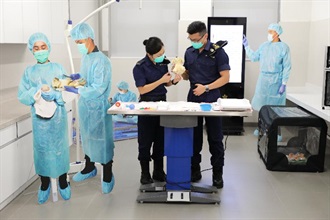
 Hong Kong Customs has achieved tremendous breakthroughs in its canine profession this year. The new breeding centre located at the Hong Kong-Zhuhai-Macao Bridge Control Point officially opened in February this year.
Hong Kong Customs has achieved tremendous breakthroughs in its canine profession this year. The new breeding centre located at the Hong Kong-Zhuhai-Macao Bridge Control Point officially opened in February this year.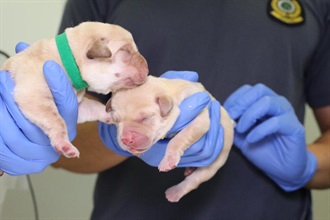
 Hong Kong Customs has achieved tremendous breakthroughs in its canine profession this year. The birth of the first batch of six self-bred Labrador puppies was a particularly encouraging breakthrough. Photo shows two of the puppies born at the newly built breeding centre.
Hong Kong Customs has achieved tremendous breakthroughs in its canine profession this year. The birth of the first batch of six self-bred Labrador puppies was a particularly encouraging breakthrough. Photo shows two of the puppies born at the newly built breeding centre.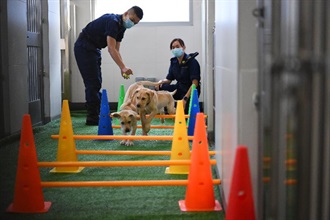
 Hong Kong Customs has achieved tremendous breakthroughs in its canine profession this year. The birth of the first batch of six self-bred Labrador puppies was a particularly encouraging breakthrough. Photo shows Customs officers training puppies at the newly built breeding centre.
Hong Kong Customs has achieved tremendous breakthroughs in its canine profession this year. The birth of the first batch of six self-bred Labrador puppies was a particularly encouraging breakthrough. Photo shows Customs officers training puppies at the newly built breeding centre.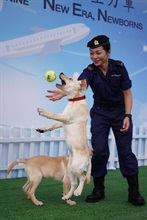
 Hong Kong Customs has achieved tremendous breakthroughs in its canine profession this year. The birth of the first batch of six self-bred Labrador puppies was a particularly encouraging breakthrough. Photo shows a Customs officer training puppies at the newly built breeding centre.
Hong Kong Customs has achieved tremendous breakthroughs in its canine profession this year. The birth of the first batch of six self-bred Labrador puppies was a particularly encouraging breakthrough. Photo shows a Customs officer training puppies at the newly built breeding centre.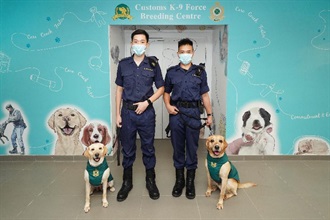
 Hong Kong Customs has achieved tremendous breakthroughs in its canine profession this year. The birth of the first batch of six self-bred Labrador puppies was a particularly encouraging breakthrough. Photo shows the puppies' mother Fifi (first left) and father Cooper (first right) and their handlers.
Hong Kong Customs has achieved tremendous breakthroughs in its canine profession this year. The birth of the first batch of six self-bred Labrador puppies was a particularly encouraging breakthrough. Photo shows the puppies' mother Fifi (first left) and father Cooper (first right) and their handlers.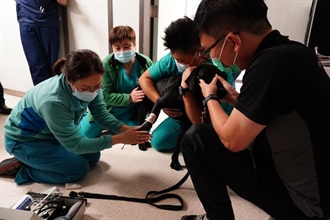
 Hong Kong Customs has achieved tremendous breakthroughs in its canine profession this year. The department collaborated with the City University of Hong Kong (CityU) this year to organise the first Canine Breeding Training Programme for the Customs Canine Force officers to raise their professionalism. Photo shows Customs officers during a lesson at the CityU Veterinary Medical Centre.
Hong Kong Customs has achieved tremendous breakthroughs in its canine profession this year. The department collaborated with the City University of Hong Kong (CityU) this year to organise the first Canine Breeding Training Programme for the Customs Canine Force officers to raise their professionalism. Photo shows Customs officers during a lesson at the CityU Veterinary Medical Centre.